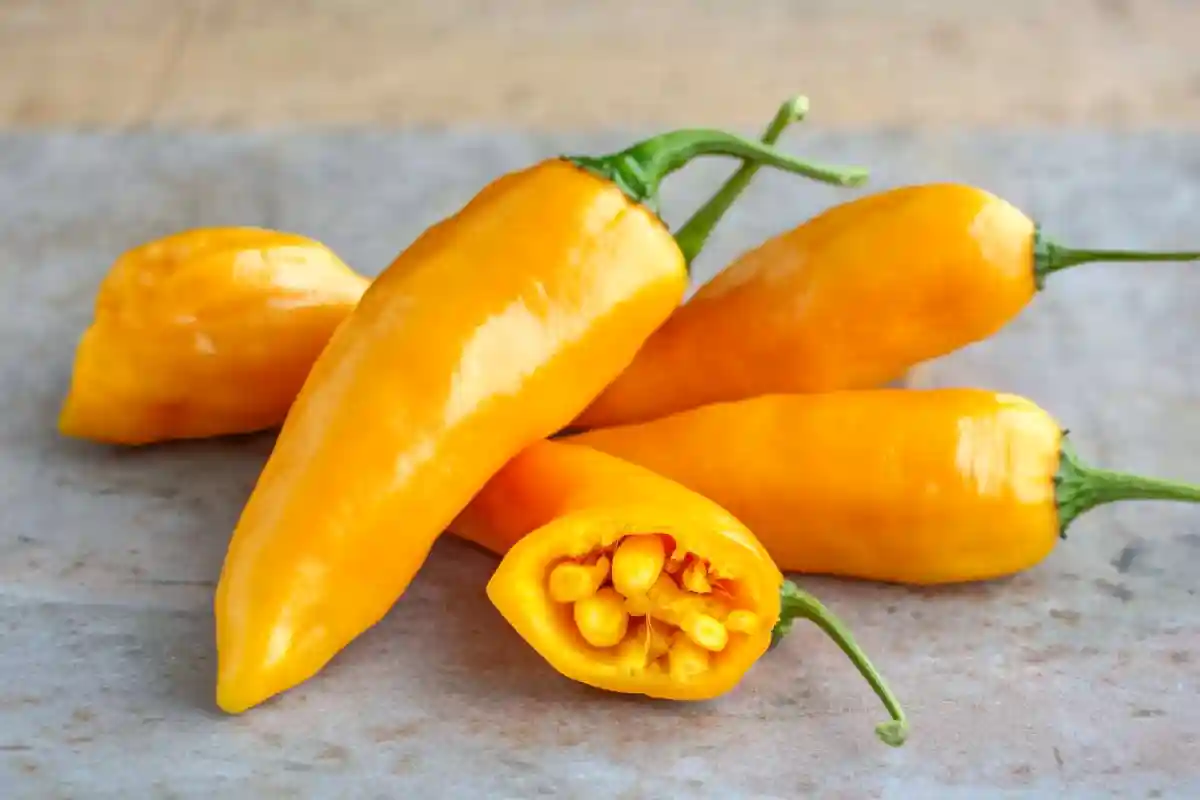
Table of Contents
I fell in love with aji amarillo when I blended fresh yellow chilies into everything from ceviche to stews. After testing four chili varieties, I landed on a simple prep: seed and roast 200 g of fresh aji amarillos, mash with garlic and lime, and finish with oil to capture bright, fruity heat in under ten minutes.
What is Aji Amarillo?
Aji amarillo, meaning “yellow chili” in Spanish, is a vibrant and essential pepper widely used in Peruvian cuisine. Although the name suggests a yellow color, the pepper actually matures to a beautiful bright orange hue. Thanks to its unique combination of medium heat and fruity sweetness, aji amarillo has become a cornerstone ingredient in countless traditional dishes, adding both flavor and character.
Typically, aji amarillo appears in several forms, such as fresh chilies, dried aji amarillo, and convenient products like aji amarillo paste and aji amarillo spice. Each form brings its own distinct flavor profile to the table. For example, aji amarillo paste is a common base for preparing the famous aji amarillo sauce, while dried aji amarillo offers a deeper, richer heat perfect for stews and soups. Additionally, the powdered aji amarillo spice is often used to season meats and vegetables effortlessly.
Moreover, incorporating aji amarillo into your cooking not only brightens the plate visually but also infuses dishes with a delightful tropical flavor. Whether you are exploring Peruvian classics or experimenting with fusion cuisine, aji amarillo provides an authentic taste that elevates every meal.
For more creative ideas using aji amarillo, you can explore delicious recipes like Aji Amarillo Chicken.
Importance of Aji Amarillo in Peruvian Cuisine
Without a doubt, aji amarillo holds a special place in the heart of Peruvian cooking. In fact, it is often referred to as the soul of Peruvian cuisine because of its essential role in creating the country’s most iconic dishes. Thanks to its vibrant color, fruity aroma, and perfectly balanced heat, aji amarillo adds a signature flavor that cannot be easily replaced.
Throughout Peru, aji amarillo is used in a wide range of traditional meals. From appetizers to hearty stews, this pepper brings both visual appeal and unforgettable taste. It is especially important in sauces, where its bright color and bold flavor shine. Moreover, many famous recipes simply would not be the same without it.
Here are some of the most popular Peruvian dishes featuring aji amarillo:
| Dish Name | How Aji Amarillo is Used |
|---|---|
| Aji de Gallina | Creamy chicken stew flavored with aji amarillo paste |
| Papa a la Huancaína | Potatoes topped with a spicy aji amarillo cheese sauce |
| Causa Limeña | Mashed potatoes layered with tuna or chicken and spiced with aji amarillo |
| Seco de Carne | Beef stew enhanced with aji amarillo for depth of flavor |
| Ocopa Arequipeña | Boiled potatoes covered in a rich aji amarillo sauce mixed with peanuts |
Additionally, Peruvian chefs often prepare a simple aji amarillo sauce as a versatile condiment to accompany grilled meats, vegetables, and even seafood. Because of this widespread use, mastering the handling of aji amarillo is considered crucial for anyone wanting to truly experience authentic Peruvian flavors.
To summarize, the importance of aji amarillo in Peruvian cuisine cannot be overstated. Whether used as a fresh chili, dried aji amarillo, or incorporated into a creamy aji amarillo paste, it remains a cornerstone of Peruvian culinary identity.
Where to Find Aji Amarillo
Finding aji amarillo may seem challenging at first, especially if you live outside of Peru. However, with the growing popularity of international cuisines, it has become much easier to locate this vibrant chili in various forms. Whether you prefer fresh, dried, paste, or spice, several options are now available both locally and online.
Here are the most common forms of aji amarillo you can find:
| Form | Description | Best Uses |
|---|---|---|
| Fresh Aji Amarillo | Bright orange peppers, slightly wrinkled when mature | Salsas, fresh sauces, grilling |
| Dried Aji Amarillo | Dehydrated whole chilies | Stews, soups, infusions |
| Aji Amarillo Paste | Smooth, concentrated chili paste | Sauces, marinades, dips |
| Aji Amarillo Spice | Ground dried aji amarillo powder | Seasoning meats, vegetables |
To locate fresh aji amarillo, it is best to check Latin American grocery stores or specialty markets. In addition, some farmers’ markets occasionally carry them during the peak season. For those seeking convenience, dried aji amarillo and aji amarillo paste are widely available through online retailers, allowing you to easily stock your pantry with this essential ingredient.
Moreover, if you are unsure where to start, visiting online stores that specialize in Peruvian ingredients is a smart move. Websites like Amazon, Mercado Latino, and Amigofoods offer a wide variety of aji amarillo products, making it simple to find exactly what you need. Furthermore, if you are interested in preparing authentic Peruvian dishes, having both aji amarillo paste and dried aji amarillo on hand will give you maximum flexibility in the kitchen.
Because aji amarillo is so versatile, stocking up on different forms ensures that you are always ready to add authentic Peruvian flavor to your meals. Whether you prefer the bright punch of fresh peppers or the deep intensity of dried chilies, aji amarillo is now more accessible than ever.
How to Use Aji Amarillo in Cooking
Cooking with aji amarillo opens up a world of vibrant flavors and exciting possibilities. Whether you are working with fresh peppers, dried varieties, paste, or spice, each form of aji amarillo offers unique ways to enhance your dishes. Thanks to its fruity notes and balanced heat, it pairs beautifully with a wide range of ingredients, making it an essential addition to any kitchen aiming for authentic Peruvian taste.
To use aji amarillo effectively in your cooking, consider the following methods:
- Fresh Aji Amarillo: Slice and sauté for fresh salsas, stir-fries, and grilled dishes.
- Dried Aji Amarillo: Soak in warm water until soft, then blend into sauces, stews, or purees.
- Aji Amarillo Paste: Stir directly into soups, marinades, and creamy sauces for instant flavor.
- Aji Amarillo Spice: Sprinkle over roasted meats, vegetables, or even popcorn for a spicy kick.
Because aji amarillo is so adaptable, it can easily elevate both simple meals and complex recipes. For example, adding a spoonful of aji amarillo paste to a basic chicken stew transforms it into a rich, flavorful Peruvian-inspired dish. Likewise, marinating fish with aji amarillo spice before grilling results in a smoky, slightly sweet flavor that is truly unforgettable.
Moreover, combining aji amarillo with other ingredients such as garlic, lime, cilantro, and onions helps to balance its heat while amplifying its fruitiness. This makes it an excellent choice not only for traditional recipes but also for creative fusion dishes.
Ultimately, learning how to use aji amarillo in different forms allows you to bring authentic Peruvian spirit to your kitchen, no matter where you are in the world.
Popular Recipes Featuring Aji Amarillo
Because of its exceptional flavor and versatility, aji amarillo features in some of Peru’s most beloved recipes. Whether you are looking to prepare a rich sauce, a comforting stew, or a vibrant appetizer, aji amarillo is the ingredient that ties these dishes together. Its fruity heat and bright color not only enhance the taste but also create stunning presentations that are sure to impress.
Here are three popular recipes where aji amarillo plays a starring role:
- Aji Amarillo Sauce (Green Peruvian Dipping Sauce):
This creamy and mildly spicy sauce combines aji amarillo paste with mayonnaise, cilantro, lime juice, and garlic. Often served with grilled meats, fries, or roasted vegetables, it brings a zesty freshness to any meal. - Aji de Gallina (Creamy Chicken Stew):
A comforting and rich dish, aji de gallina features shredded chicken in a sauce made with aji amarillo paste, bread soaked in milk, cheese, and walnuts. The result is a flavorful stew that balances creaminess with the gentle heat of aji amarillo. - Papa a la Huancaína (Potatoes in Spicy Cheese Sauce):
This classic Peruvian appetizer consists of boiled yellow potatoes draped in a creamy, spicy sauce made from aji amarillo, fresh cheese, milk, and crackers. Typically served cold with black olives and hard-boiled eggs, it showcases the unmistakable flavor of aji amarillo.
Because each of these dishes relies heavily on the unique taste of aji amarillo, having high-quality aji amarillo paste or dried aji amarillo on hand is essential. Whether you are preparing a traditional Peruvian feast or simply looking to spice up a weeknight meal, aji amarillo offers endless culinary possibilities.
FAQs About Aji Amarillo
What is the flavor of aji amarillo?
The flavor of aji amarillo is truly one of a kind. Although it delivers a moderate level of heat, its most distinctive characteristic is its vibrant fruitiness. Many people describe the taste as a mix between passion fruit and mango, offering a sweet yet spicy profile. Because of this unique combination, aji amarillo enhances dishes without overpowering them, adding both depth and brightness to a wide range of recipes.
Is aji amarillo pepper spicy?
While aji amarillo does bring some heat, it is considered moderately spicy compared to other chili peppers. It typically measures between 30,000 and 50,000 Scoville Heat Units (SHU), placing it comfortably between jalapeño and cayenne peppers. However, thanks to its fruity undertones, the heat of aji amarillo feels smooth and well-balanced, making it an excellent choice for those who enjoy a flavorful kick without overwhelming spiciness.
What pepper is closest to aji amarillo?
If you cannot find aji amarillo, the best substitutes are orange or yellow habanero peppers, although they are often spicier. Milder alternatives include Hungarian wax peppers or banana peppers, though they lack the fruity complexity. Another good option is using a blend of mild chilies with a touch of fruity sweetness to replicate the taste of aji amarillo as closely as possible.
What is aji amarillo made of?
When referred to as a product, aji amarillo is usually processed into different forms like paste, dried peppers, or powder. Aji amarillo paste, for instance, is made by blending fresh aji amarillo peppers with a small amount of oil, salt, and sometimes vinegar for preservation. This concentrated form captures the pepper’s fruity heat perfectly, making it a convenient way to add authentic Peruvian flavor to any dish.
